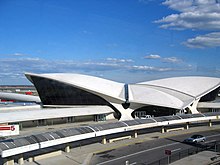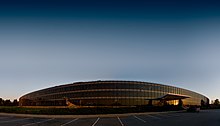Eero Saarinen

Eero Saarinen (born August 20, 1910 in Kirkkonummi , Finland ; † September 1, 1961 in Ann Arbor , Michigan ) was one of the most famous architects and designers of the 20th century.
biography
Saarinen was the son of Eliel Saarinen , another well-known architect. In 1923 the Saarinen family emigrated to the USA . The family lived on the Cranbrook Educational Community campus in affluent Bloomfield Hills ; the father himself had designed the architecture of this campus.
From 1929 to 1930 Eero Saarinen initially studied sculpture at the Académie de la Grande Chaumière in Paris . This was followed by architecture studies from 1930 to 1934 at the Yale School of Art and Architecture . He then joined his father's architectural office and became a partner there in 1941. In 1940 he took part with Charles Eames in a competition at the Museum of Modern Art in New York. Several of her designs, including the Organic Chair , won in the various categories.
In 1948 he won his first major public recognition with the competition for the Jefferson National Expansion Memorial in St. Louis . There he competed against internationally renowned architects, u. a. also against his father. The enormous arch was only completed after Eero Saarinen's death in 1963.
In 1950 he opened his own architectural practice Eero Saarinen and Associates in Birmingham , Michigan . In 1954 he was elected to the American Academy of Arts and Sciences and the American Academy of Arts and Letters . In 1957 he designed the Milwaukee Art Museum .
Saarinen initially orientated himself strongly on the strict cubic forms of Ludwig Mies van der Rohe , before he found more expressive forms in the course of time, which are strongly reminiscent of sketches by Erich Mendelsohn . Its sweeping, self-supporting roof structures are particularly well known.
In addition to buildings, Eero Saarinen also designed furniture. Famous is his one-legged " Tulip Chair " ( Tulip Chair ) with its wide, circular base and the Womb Chair from the year 1948th
In the competition for the Sydney Opera House from 1956 to 1957, Eero Saarinen was chairman of the jury. He is said to have given a decisive turn to this competition by bringing to light the already rejected design by the eventual winner Jørn Utzon between the documents and recommending it to the attention of the jury. In 1958 Saarinen was elected a member ( NA ) of the National Academy of Design in New York .
Saarinen died at the age of 51 as a result of a brain tumor operation. After Eero Saarinen's death, his colleagues Kevin Roche and John Dinkeloo continued to run the office under his name until 1966 (after which it was renamed Kevin Roche John Dinkeloo & Associates ) and ensured that the work that had started was completed.
Works (selection)
- General Motors Technical Center , Warren , Michigan, 1949-1956
- Kresge Auditorium at MIT , Cambridge, Massachusetts, 1953–1955
- Trans World Airlines Terminal ( TWA Flight Center ) at John F. Kennedy Airport , New York , posthumously, 1956–1962
- Suspended roof at Dulles International Airport , Washington, DC , posthumous, 1958–1962
- John Deere and Company Administration Center , Moline , Illinois, posthumous, 1957-1963
- Terminal Hellenikon Ost at Ellinikon Airport in Athens , 1960–1963
- Thomas J. Watson Research Center , Yorktown Heights, New York , 1961
- American embassies in London and Oslo
- Jefferson National Expansion Memorial ("Gateway Arch"), St. Louis, posthumous, 1963
- Vivian Beaumont Theater , New York City, with Jo Mielziner , posthumously, 1965
Kresge Auditorium at MIT (1953–55)
MIT chapel, outside
MIT chapel, inside
Yale University Ingalls Ice Rink
literature
- Pierluigi Serraino: Eero Saarinen 1910–1961. A functional expressionist . Köln, Taschen Verlag 2005. 96 pages, ISBN 3-8228-2865-3 .
- Eero Saarinen: Shaping the Future . Ed. Eeva-Liisa Pelkonen. Publisher: Yale University Press, 2011. ISBN 978-0-300-12237-4
Web links
- Literature by and about Eero Saarinen in the catalog of the German National Library
- Eero Saarinen. In: arch INFORM .
- Saarinen at the Finnish Cultural Institute in New York
- Eero Saarinen: Shaping the Future. Exhibition May 3, 2008 - August 24, 2008
- Eero Saarinen: Shaping the Future is co-presented in Minneapolis by the Walker Art Center and the Minneapolis Institute of Arts.
- Making the Face of Modernism Familiar. The New York Times, November 10, 2009
Individual evidence
- ↑ Members: Eero Saarinen. American Academy of Arts and Letters, accessed April 24, 2019 .
- ↑ nationalacademy.org: Past Academicians "S" / Saarinen, Eero NA 1958 ( Memento of the original from March 20, 2016 in the Internet Archive ) Info: The archive link was inserted automatically and has not yet been checked. Please check the original and archive link according to the instructions and then remove this notice. (accessed on July 15, 2015)
- ↑ smow.de: Happy Birthday Eero Saarinen
| personal data | |
|---|---|
| SURNAME | Saarinen, Eero |
| BRIEF DESCRIPTION | Finnish-American architect |
| DATE OF BIRTH | August 20, 1910 |
| PLACE OF BIRTH | Kirkkonummi , Finland |
| DATE OF DEATH | September 1, 1961 |
| Place of death | Ann Arbor , Michigan, USA |







